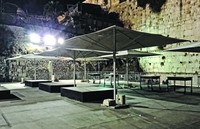There’s more to the Western Wall than you think
There is a place called the Seventh Step, and it was once one of the most coveted prayer spots in the Jewish world. Never heard of it? I’m not surprised. Praying at that spot fell out of practice several decades ago.
Situated in Hebron, next to Maarat Hamachpela (The Tomb of the Matriarchs and Patriarchs), the Seventh Step was the closest Jews could get to the tombs of their forebears Abraham, Isaac, Jacob, Sarah, Rebecca and Leah because for 700 years, non-Muslims were banned from entering. Now the ban is over and Jews are permitted to visit these tombs. There is no more need to limit ourselves to a single step.
Now let’s zoom in on a section of the Western Wall known as the Western Wall plaza. (It is also known as the Kotel, or “wall,” and can refer to all four sides of the retaining walls that surround the Temple Mount.) It has been the primary site of Jewish worship for many years.
Notice how I didn’t refer to it as Judaism’s holiest site, because it isn’t. That distinction goes to the Temple Mount, on the other side of the Western Wall. It was here that Jews believe the Holy Temple stood on the holiest spot on the planet – the Holy of Holies, where the Ark of the Covenant was housed. It’s this place that Jews around the world pray toward, not the Western Wall plaza. This plaza is like the Seventh Step – we only need it until we can pray freely on the Temple Mount.
Unfortunately, it is at the Western Wall plaza where clashes sometimes erupt between those wishing to maintain the status quo of Orthodox-style prayer and structure at the plaza (with a separation of men and women) and those who want to have an egalitarian section.
As a result of this discord, the Israeli government constructed an egalitarian section at the wall a few meters south of the Western Wall plaza, along the continuation of the wall near Robinson’s Arch.
For those who claim that this section isn’t as good because the Western Wall plaza has always been regarded as the “main” section of the wall, there are two facts to keep in mind: 1) As mentioned above, the Western Wall plaza is not Judaism’s holiest site. 2) The Western Wall plaza is not the entire Western Wall, but rather just a small portion of a much larger wall that goes all the way along the western side of the Temple Mount.
So what makes this small section of the Western Wall so important that people argue and fight over it? The same thing that made the Seventh Step so important until a few decades ago – the people who popularized it.
I went to the egalitarian section of the Western Wall on two separate occasions. The experiences were so similar that I will only share one of them here. This took place during the intermediate days of Sukkot. That evening, the men’s and women’s sections of the Western Wall plaza were packed.
With a female friend, I walked to the egalitarian section. It was spacious and had several bimahs (altars) for people to congregate around. There was one thing missing from this area, however: People. At the exact same moment that thousands upon thousands of people were gathered at the Western Wall plaza, the egalitarian section of the Western Wall was almost devoid of life. The only other people there were an Ultra-Orthodox family. They stood together, mother next to sons, as they prayed and danced near this part of the Western Wall that they had virtually all to themselves.
While the space along the actual wall was very small, there were so few of us in the egalitarian section that we had plenty of room compared to the people trying to squeeze into a spot along the wall in the Western Wall plaza.
The egalitarian section was so nice that we decided to say our prayers there and not even deal with the frenzy of people at the Western Wall plaza. We understood that a wall is just a wall, and this section was no less important to us than the Western Wall plaza.
On our way out, we noticed that there was no security guard on watch at the egalitarian section. We asked a nearby guard why. His response: “Because no one ever goes there.”
The bottom line is that the only reason why the Western Wall plaza is such an important site is because devoted Jews worship there day after day, not just on Sabbath or Rosh Hodesh. They are there, praying, every hour of every day, 24/7. And those who are happy to maintain the status quo of men and women praying separately at the Western Wall plaza make up a clear majority in the plaza.
My own bottom line is this: Whoever wants the Jewish world to believe that the Western Wall plaza is just as important to them as it is to those who pray there regularly must come and prove it, like the groups that are represented 24/7 in the plaza. If it’s not about politics, then those who want to use the egalitarian section should show the world that they care and are committed to maintaining this area of the Western Wall. Like the Seventh Step in Hebron and the Western Wall plaza, we can make the egalitarian section of the Western Wall a sacred place by simply being there and using it regularly.
DANIEL STIEGLITZ (dstieglitz@gmail.com) is a certified Life Coach and a freelance writer who lives in Jerusalem. His new collection of short stories, “Tavern of the Mind,” is available for purchase at Amazon.com.











